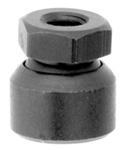
Have you heard of toggle pads? While they look like ordinary nuts attached to a wide base, they are ideal for clamping applications involving parts with an uneven or irregular surface. Not all parts have a smooth, even surface. Some parts may have an uneven or irregular surface. To clamp these parts, you should consider using a toggle pad.
Overview of Toggle Pads
Toggle pads are clamping components that are designed for parts with an uneven or irregular surface. They are self-aligning and self-leveling. When exposed to a load, toggle pads will align and level themselves with the workpiece’s surface.
How Toggle Pads Work
As shown in the photo above, toggle pads feature a simple design. They consist of a nut attached to a wide base. The nut, however, has a swiveling mechanism.
The degree to which a toggle pad can swivel may vary. Most toggle pads can swivel at a 10-degree angle. This rotation allows them to align and level automatically with the workpiece’s surface. Toggle pads will swivel when exposed to a load so that they align and level with the workpiece’s surface.
Benefits of Using Toggle Pads
Toggle pads offer several benefits. For parts with an uneven or irregular surface, there’s no better type of clamping component than a toggle pad. Toggle pads feature a swiveling mechanism that provides self-alignment and self-leveling benefits with parts. Maybe a part has an angled surface, or perhaps a part has a textured surface. Regardless, you can clamp it with a toggle pad.
Another benefit of toggle pads is protection from slippage. Unlike other types of clamping components, toggle clamps won’t slip. When exposed to a load, they’ll remain stationary while ensuring that the parts are properly aligned and level with the workpiece’s surface.
Toggle pads are available in different materials. Steel is a common material in which they are made. Toggle pads made of stainless steel are strong, durable and resistant to corrosion. You can also find them made of carbon steel. Carbon steel toggle pads are exceptionally strong, but they lack the corrosion-resistant properties of their stainless steel counterparts.
In addition to steel, toggle pads are available in nylon. Nylon is a type of synthetic plastic. Therefore, it’s immune to corrosion. Nylon toggle pads won’t rust or corrode. They are also lightweight and inexpensive. Stainless steel, carbon steel and nylon are some of the most common materials in which toggle pads are made.
